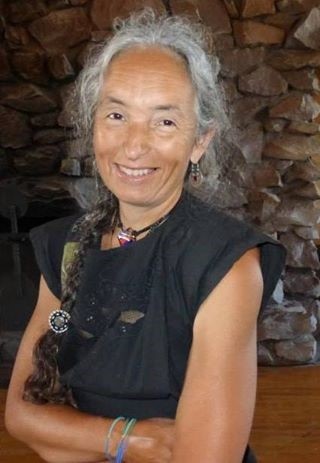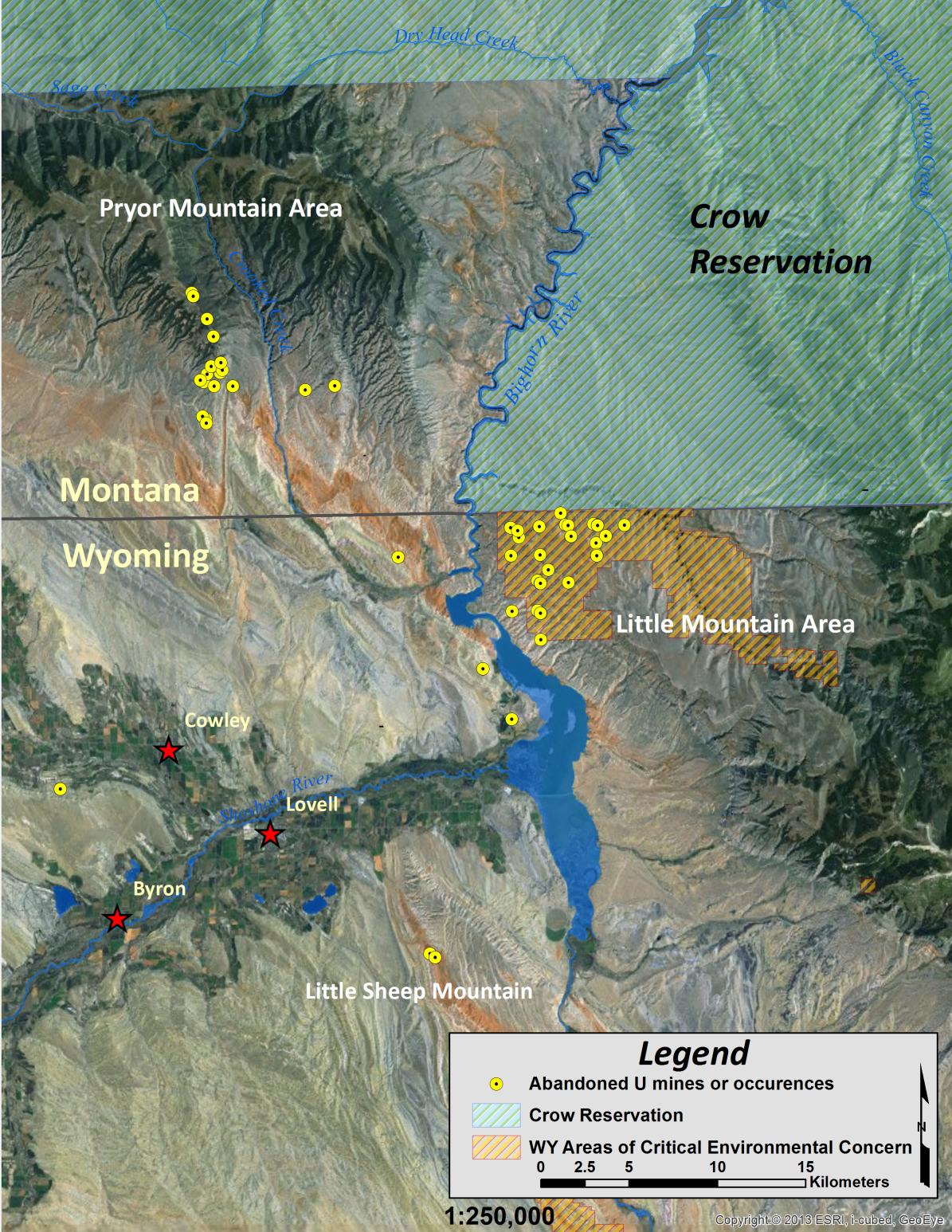Catching Up With a Current Student
Return to MSU Graduate School Homepage
Established by the A.P. Sloan Foundation, the Sloan Indigenous Graduate Partnership aims to increase the number of Indigenous Americans earning master’s and doctoral degrees in STEM disciplines.
Meet a Sloan Scholar
Anita Moore-Nall
Ph.D. Candidate, Earth Sciences

Hometown: Browning, MT, member of the Crow Tribe
Education History: B.S., Montana State University, Earth Science
B.S., Montana State University, Film & Television Production
Honors: Sloan Scholar
Selected Publications
Abstracts at Conferences
A note from The Graduate School - Anita successfully defended her dissertation on November 18, 2016. Congratulations Dr. Moore-Nall!
In Her Own Words...
My study area is in the Pryor Mountains, Carbon County Montana, the Little Mountain Mining District, Big Horn County, Wyoming and Kane Cave area in the adjacent Little Sheep Mountain anticline, Big Horn County, Wyoming. The title of my dissertation is:
“Physical and chemical characterization of brecciation and U-V mineralization in the Madison Limestone and adjacent units, Big Pryor Mountain mining district, Montana – Little Mountain mining district, Wyoming”.
I am looking at abandoned uranium/vanadium mines in these districts to see if the mineralization of these deposits may provide some information on the lead and mercury contamination of the Bighorn River once it flows through the Crow Reservation. The two districts straddle the Bighorn River upstream from the Crow Reservation. I am also looking at the Little Sheep Mountain area of Wyoming as a possible modern analog to the mineralization of the districts as it is a geologic structure that the Bighorn River has been superimposed on and has an active geothermal spring with metals including U and Pb present in the water. The structure is close to the two districts. The title of my project reflects the geologic nature of the project though I believe one aspect of this research project is significant for looking at the water quality as a function of mining contaminants or possibly through natural migration of metal enriched hydrothermal fluids along fractures that may enter the Bighorn River and contribute to the elevated levels of Hg and Pb or along surface water drainages enriched with mobilized metals in sediments or organic matter. Based on data from USGS regional water resources investigation of the Yellowstone River Drainage basin(1999) and another on organic elements and trace elements concentrations in bed sediments and fish tissue (1998), the Bighorn River was listed as a 303d impaired water body downstream of the Crow Reservation. The fish of the Bighorn River had the highest Hg and Pb concentrations of all the EPA sites studied across the nation at that time. Drainages from the two uranium mining districts, Little Mountain Mining District, Wyoming and Pryor Mountain Mining District, Montana, both flow into the Bighorn River just upstream of the Crow Reservation. Bed sediments and water were not anomalously high from the selected steams representative of these areas in the studies for uranium. Lead and mercury, however, were not the emphasis in the studies, which might indicate a need to reexamine available data to locate the source of contamination for the Bighorn River area. Groundwater and natural springs, such as the warm springs in the Kane Cave area, could also be contributing to the addition of these elements as well as other elements like Cu, As and Mo.
I have collected samples from these areas and worked on some of the analysis and interpretation of the data. I am currently writing up my dissertation and completing analysis for some parts of it.
The study area map is on the last page of this brief synopsis of my research project.

Anita Moore-Nall and David R. Lageson, Elevated REE in Ore Minerals of the Pryor Mountain Mining District, South Central Montana, May 9, 2015, Montana Bureau of Mines and Geology Mining and Mineral Symposium, (presented a talk and a poster here) extended abstract to be published through the MBMG.
Moore-Nall, Anita. "The Legacy of Uranium Development on or Near Indian Reservations and Health Implications Rekindling Public Awareness," Geosciences 5, no. 1 (February 2015): 15-29. DOI:https://dx.doi.org/10.3390/geosciences5010015.
Eggers MJ, Moore-Nall AL, Doyle JT, Lefthand MJ, Young SL, Bends AL, Crow Environmental Health Steering Committee, Camper AK, "Potential health risks from uranium in home well water: An investigation by the Apsaalooke (Crow) tribal research group," Geosciences, 2015; 5(1):67–94.DOI:https://dx.doi.org/doi:10.3390/geosciences5010067
The following have all been abstracts at conferences:
Anita Moore-Nall and David R. Lageson, Isotopic evidence from late-stage calcite in brecciated host rocks from abandoned uranium vanadium deposits in Montana and Wyoming suggests a possible hydrothermal source, 2012,GSA Annual Meeting in Charlotte, North Carolina (4–7 November 2012) Paper No. 30911-213381. (Also presented the same at the SACNAS conference in Seattle 2012; MSU Earth Science Colloquium April 12-13, 2013)
Anita Moore-Nall and David R. Lageson, Elevated uranium and lead in wells on the Crow Reservation, Big Horn County - A Potential Problem, 2012, GSA Annual Meeting in Charlotte, North Carolina (4–7 November 2012) Paper No. 31920-213432. (Also presented the same at the SACNAS conference in Seattle 2012; MSU Earth Science Colloquium April 12-13, 2013)
Anita Moore-Nall and David R. Lageson, Elevated Lead in the Bighorn River may be naturally distributed through reactivated Precambrian fault systems, 2011, GSA Annual Meeting in Minneapolis (9–12 October 2011) Abstract ID#: 195191 (also presented in the MT-AWRA meeting as a talk)
Anita Moore-Nall and David R. Lageson, Herkimer Diamonds in the Pennsylvanian Tensleep Formation may indicate hydrothermal influences for mineralization of the Red Pryor Mountain Uranium/Vanadium deposits, 2011, GSA Annual Meeting in Minneapolis (9–12 October 2011) Paper No. 247-11 (Also presented the same at the SACNAS conference in San Jose, California, 2011).
Anita Moore-Nall and David R. Lageson, Fault-related Hydrothermal Dolomitization may be a model for U/V mineralization in the Madison Limestone and adjacent units, Pryor Mountains, Montana – Little Mountain area, Wyoming and may be linked to dewatering of the Bighorn Basin during Laramide orogenesis, 2011, MSU Earth Science Colloquium.
Anita Moore-Nall and David R. Lageson, Hydrothermal influences for U-V mineralization in the Madison Limestone and adjacent units, Pryor mountains, Montana –Wyoming and a possible link to elevated Pb and Hg in the Big Horn River in Montana, 2010, GSA Annual Meeting in Denver (31 October- 3 November 2010) Paper No. 246-16
